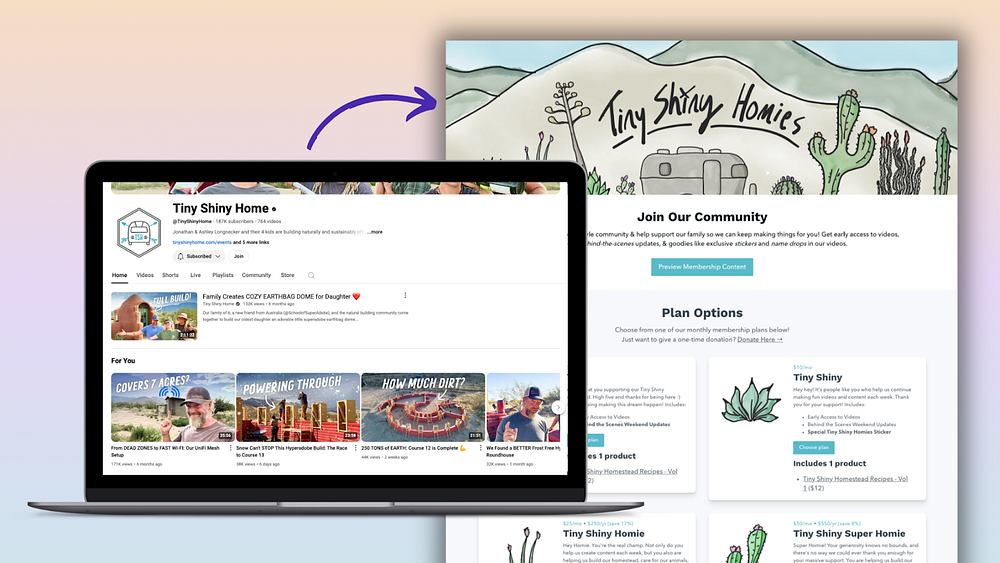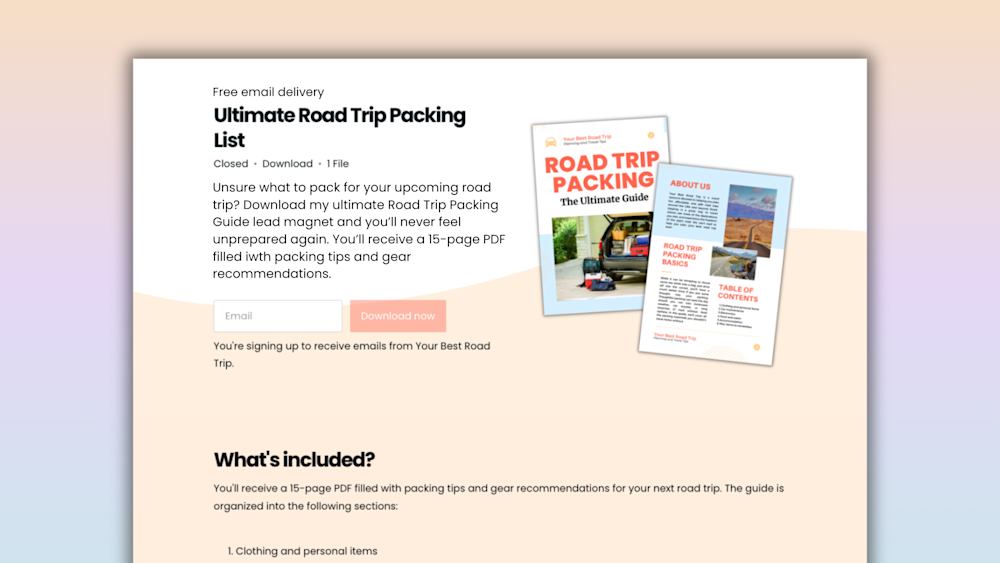You know that your product idea is awesome.
I know that your product idea is awesome.
But your customers don’t know that yet, and whether or not people are willing to pay for your idea is still up in the air, too.
The solution for letting customers know and finding out if they’ll fund your idea is simple, and works for any product type: you need to validate your idea with your target customers prior to creating a full-fledged product.
As fancy as it might sound, validating your product idea doesn’t mean investing thousands in focus groups and statistical analyses.
Instead, it can be completed in just four steps: conducting customer research, creating a test product, beefing up your marketing efforts, and improving your product.
First up, let’s talk about researching your market.
Step #1: Conduct market research
Contrary to what many people think, people don’t buy things simply because they’re attractive.
People buy things because they’re trying to solve a problem. For some people, that could be wanting to learn a new skill so they can get a promotion or switch careers.
For others, it could be learning a new skill or subject area that could boost their standing in their social circle.
Either way, if your product can’t solve a problem, it’s not going to sell well.
Let’s say you want to teach a course on productivity for people who want to “have it all” -- time with their family and friends, work on their hobbies, achieve their professional goals, and so on.
Probably 99% of the population would benefit from becoming more productive, but that’s not a problem most of us are actively trying to solve.
Instead of trying to appeal to a broad audience and convince them they a) aren’t productive, b) want to become productive, and c) that your course is the best solution, there’s an easier way to go.
Chiefly, create a course for people who are already looking for ways to become more productive instead. That eliminates two out of three of your marketing challenges.
To find people aware and actively trying to solve a problem, start with effective customer research.
Find out where your target customers are hanging out online -- Facebook groups, Reddit, Product Hunt, and the like -- and read their comments.
Then, answer their questions and ask questions of your own.
Send out surveys to your email list and social media followers, and try to interview a few customers in-person or via teleconferencing, as well.
When you’re researching and interviewing your customers, don’t just ask questions centered around product features.
Make sure to ask about non-product features, too, such as customer service or brand values, that your target customers yearn for in their customer experience.
Why? Because 32% of customers would stop buying from a brand after one bad experience, and 59% of American shoppers will walk away after several bad experiences even if they love the company or product.
Plus, with 76% of customers saying it’s never been easier to take their business elsewhere, why not make their decision easier -- and earn their loyalty and dollars -- by creating a great product that meets all of their needs?
In line with offering customers a great experience with your brand, you could also focus on connecting with each of your customers and treating them like people.
That might sound fluffy, but it’s a tragically prolific problem.
56% of consumers feel marketers spend too much time trying to make them pay attention rather than finding ways to make them want to do so, according to the 2018 Edelman Earned Brand study.
Outside of that, when asking your questions or sending out surveys, don’t just gather statements about how much people do or don’t want to buy your potential product -- collect preorders while you’re at it.
Having people pay you for something you haven’t produced yet sounds a little crazy, but it’s a commonly accepted business practice, and a savvy way to validate your product idea and fund your business from the beginning.
You see, when you get preorders from a product, you involve customers in the product creation process, meaning you can create something directly catering to your customers’ preferences.
Plus, each of those preorders means extra money in your bank account you can use to buy tools for your online courses, such as site builder or video editing software.
Preorders aren’t just beneficial in the short-term, too. They’re also a superb way to drum up excitement for your product. LaTweez, for example, earned over 150,000 preorders for a pair of ombre tweezers they were pre-selling.
Aside from the obvious financial benefit of 150,000 preorders, LaTweez also said preorders were helpful for figuring out where new customers were coming from.
In turn, this likely helped them market on the appropriate channels to these new customers.
Wax brand, Waksé, saw similar results when they made a spring announcement about launching a new product in the following October. They earned over 8,000 preorders and were projected to earn over 1 million in revenue in their first year.
As you can see, pre-ordering is a gift that keeps on giving for brands trying to break into the scene.
But, while you’re collecting preorders and finding out more about your audience, you might realize your audience is actually quite diverse.
How are you supposed to launch your product and solve a problem for a narrow group of people when your audience is so varied?
Easy -- you create buyer personas.
What is a buyer persona and why you need one
Buyer personas are “characters” based on the traits, histories, and personalities of many of your customers.
Businesses should have multiple personas -- chances are, you probably appeal to multiple groups of people.
However, for your test product, aim to appeal to only one or two segments so you can please a highly-targeted group of people.
To get started, you can create a buyer persona with these templates from Xtensio and HubSpot.
When creating a buyer persona, you’ll want basic information such as their age range, income range, level of education, and geographic location, among other details.
For more targeted marketing and product development, add in further information such as what their interests and hobbies are, their professional or personal goals, other businesses they’ve purchased from, and what they like or dislike about your competitors.
Let’s say I’m creating an online course about writing flash fiction, which are short stories under 1,000 words.
There are probably many groups of people who want to write flash fiction -- amateur writers, published writers, writing students, and people who are interested in more avant-garde forms of writing.
However, for my online course, I’m only going to try to appeal to amateur writers.
They’re passionate about writing, have discretionary income (which most writing students probably don’t) and are a large enough group that I can attract sufficient feedback for testing my product.
Through my research, I find that many of the amateur writers have an income of $60,000 to $100,000, live in major cities, belong to at least one writing group, and aspire to become published.
As such, when I’m creating my product prototype and sales page (which we’ll go over in the next two steps), I’ll make sure to incorporate features and use language that caters to this group of people. Thanks to the persona, I’ve got a quick reference for doing so.
This is the gist of it:
The first step in validating your product idea -- conducting customer research -- involves getting to know your customers’ product preferences and requests more deeply so you can provide a viable solution to their problems.
Once your research is completed, you can move on to the second step: creating a test product.
Step #2: Create a product prototype
When you’re validating your digital product idea, you’ll want to create a product prototype -- also known as a minimum viable product (MVP) -- that you can continuously improve and iterate on as you gather feedback from your customers.
MVPs are highly prevalent amongst the world’s most popular companies.
Facebook, for example, started as an MVP. It was originally only intended for university students before it became what it is today through regular testing and feedback.
Likewise, photo-sharing website Unsplash started as a Tumblr blog with 10 photographs, while Product Hunt started as a link-sharing website called Linkydink.
Like Facebook, Unsplash, and Product Hunt, your prototype shouldn’t have all of the bells and whistles you want your dream product to have.
Ideally, your MVP should have the bare minimum content to teach one tangible skill or solve one basic problem.
Going back to my flash fiction class, I won’t create an hours-long course about fleshing out a story, creating characters, setting and scene, and the like.
Instead, I will teach one specific skill, creating three-dimensional characters in 100 words. This skill, in turn, solves one specific problem -- creating compelling characters in super-short stories -- for a very narrow niche.
You don’t have to create all of your MVP content from scratch, by the way. If you have a popular blog, there are several ways to repurpose it for an MVP, such as turning your blog content into an ebook or video course.
And, whether you create custom or repurposed content, don’t sweat it if your MVP isn’t a hit at first -- just go back to the drawing board, conduct more customer research, and make some tweaks.
After all, if a company like Google has 171 failed or shuttered products and services, it’s far less of a catastrophe than you think to have an MVP which isn’t an instant hit as a smaller creator.
Once your MVP starts getting some traction, you should consider creating an affiliate marketing program or referral program for your early customers so as to encourage word-of-mouth marketing.
30% of Americans make a recommendation at least weekly, and 55% make recommendations at least monthly, so why not incentivize and reward them for talking about your brand?
Working with influencers to spread the word about your MVP can also be a smart marketing tactic, although it’s probably best saved for after your MVP has gone through an iteration or two so it’s more polished.
Just make sure whatever influencers you reach out to are a genuine fit for your audience and have a reputation for recommending products they personally believe in.
90% of marketers say authenticity is critical to the future of influencer marketing, so working with an influencer who’s a poor match or who has a reputation for prioritizing sponsorships over great recommendations for their audience can possibly damage your MVP’s spread.
Learning what your customers want is the first step of validating your product idea, but the second is turning those findings and recommendations into a product prototype.
OK, now you have a prototype and research in hand . . . but you’re not quite done validating it yet. Next, you need to check your assumptions and test your interpretations by creating a sales page for your idea.
Ideally, you’ll collect pre-sales while you’re at it, too.
Step #3: Create a sales page
As you’re developing your product prototype, you should work on your sales page (also known as a landing page).
Unlike a product page, which lists the main features of a product, a sales page is like an extended written conversation with your readers.
It’s where you can address your audience’s questions and concerns about your product, speak to their aspirations, include a FAQ section and testimonials, and more.
Writing a sales page that converts isn’t too hard -- it simply involves answering your customers’ questions.
Sales page can be long or short, though shorter is better if your customers’ are highly aware of their problem, the solutions available, and your brand/product.
A longer sales page is better if your customers aren’t as aware of their problem, how to solve it, or the quality and offerings they can expect from your brand.
So although the average top landing pages are 653 words, focus on making your landing page as comprehensive as it needs to be to help your customers make a buying decision.
To make your sales page more informative and memorable, consider adding video with a tool like Biteable -- after all, 25% of top landing pages had video and people pay the most attention to video content.
To increase customer interest and conversions, you could also include a sneak preview of your product, whether you’re selling a digital download, course, or membership plan, such as how Mahakatha did for their “Ancient Chants from India - Volume 1” recordings.
Whether you want your sales page to be at true sales page where people can pre-order your product or a landing page where they can join your email list to receive updates about your product, you’ll need a landing page builder to create an eye-catching, high-converting page.
Most popular landing page builders come with similar functionality, so don’t agonize over picking the “right” one too much.
In addition to your landing page, you’ll need some way to manage your customers’ and subscribers’ email addresses so you can update them about your product’s development.
As with landing page builders, there are plenty of reputable email marketing tools that offer similar features and functions, especially if your list runs on the small side.
Alternatively, to make the most of your time and start-up investment, consider using an all-in-one website, sales page, product page, and email list builder like Podia.
Podia allows creators to create sleek landing and sales pages, such as this simple-yet-compelling “coming soon” landing page from House of Royalties, which can then be used to grow their lists or attract sales.
Sign up for a free 30-day trial of Podia today to take our easy website builder for a spin.
Now, for our final step today, we’ll go over how you can gather feedback to create ever-more-phenomenal products.
Step #4: Gather feedback and release your prototype again
After your early customers have used your digital products for a few weeks, start seeking feedback.
Live feedback through video conferencing or in-person meetings is ideal, but a mix of in-person and online feedback should give you sufficient data.
Stopping and accepting more feedback may seem like putting the brakes on your development again at this stage, but it’s critical for polishing out any new rough patches that arise between product prototype and finished product.
Reuven Lerner learned this lesson after gathering feedback that his students enjoyed his course, but found it too long at over four hours.
In turn, Reuven chose to narrow his initial course -- and subsequent courses -- into smaller but more targeted courses.
On that note, don’t fret if your customers give you some less-than-desirable feedback -- 90% of consumers will give a brand a second chance after a bad experience.
However, only 52% of consumers worldwide believe that brands take action on their feedback, so it’s imperative you respond to your customers’ feedback promptly and incorporate it into your future products if it’s something a large enough group of customers request.
Once you’ve gathered and acknowledged this feedback, it’s time to redesign your MVP several more times until you receive mostly positive feedback from your customers and you’ve developed a fully functional, sellable product.
Even once you release your product for sale, don’t be afraid to pivot your product’s direction if that’s what is ultimately best for your customers.
As an example, maker Justin Jackson created a 14-day free email drip sequence called Tiny Marketing Wins and attracted almost 4,000 subscribers.
After the 14-day period, subscribers asked Justin if he would continue the program -- and he said it was only feasible if it was a paid subscription.
When he launched a paid version of Tiny Marketing Wins of 2017, hundreds of people paid the program’s $249 annual fee.
A few months in, Justin noticed that his subscribers weren’t completing the program’s tactics as quickly as he had thought, so he reached out to his users for feedback and made some changes.
Justin realized that he had a product on his hands that his students’ loved, it just wasn’t in the best format for them, so it was time to change.
You might find yourself in that same position, and that’s OK. Just don’t get too married to a single format or feature: ultimately, your product isn’t for you.
It’s for your customer. The more you build, validate, and iterate on that principle, the more success you’ll have.
Prove your product idea and please your audience
Very rarely do profitable products start off as “shots in the dark”.
Look at any successful product today, from Facebook to Airbnb, and you’ll likely see a product that makers first needed validation for f before it became the product people know and love today.
To validate your product idea, there are just four steps you can take:
-
Conduct marketing research and create buyer personas so you can better understand what your target customers want in a product and what drives your customers to make a purchase.
-
Create a product prototype -- also known as a minimum viable product -- that you can use to test your findings and assumptions about your customers.
-
Put together a sales page where people can learn more about your product and even pre-purchase it.
-
Lastly, iterate on your product prototype using feedback from your early adopters until you have a fully sellable product.
Validating your product idea, whether that’s an online course or a membership or even a physical product, isn’t hard to do.
You just need to dedicate time, effort, and ingenuity into getting to know your customers so you can create products that improve their lives.
Do that, and the rest is, as they say, gravy.



